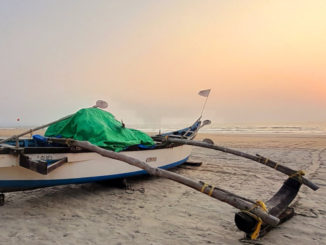Welcome back time-travellers. We have landed in mid-August 1997 at Scalloway on the Mainland of Shetland and are about to set sail for Fair Isle.
Before we cast off from the Boating Club’s pontoon I’d like to pay my usual tribute to all those who commented on part 25 of these tales and remark on some of them.
FJ is right that Raffles arrival in Singapore gave a significant boost to the British presence in SE Asia but he was preceded by Francis Light who started development of George Town on Penang Island some 33 years earlier. I’m hoping to find enough time and space on another occasion to say a little about both men and their times. Likewise about Brookes and Sarawak mentioned by one member of the Pureblood family. I wonder whether the latter’s related to some-one with a similar name who went looking for surf in Western Sumatra on a beautiful yacht that I suspect was owned commercially or by a very rich friend. It’s even possible both Purebloods might be connected with a third person who’s familiar with the coast of Southern Ireland. I’m not going to speculate any further though because sometimes it’s hard to tell one Puffin from another as they all have such a similar shape and plumage.
FJ is also right about the huge size of the larger species of albatross that typically weigh about 20 lbs. That’s about three times heavier than a large chicken and just under half the weight of a large swan. Like swans they have to work hard and long to get into the air from the water and perhaps even harder because their wings are designed for gliding rather than flapping. They have the longest wingspan of any bird at up to 12 feet and can travel at a rate of about 600 miles per day. Some have been known to cover 15,000 miles in a month and typically three million miles in a 50-year lifetime. They only return to breeding sites on land once a year and can stay in the air or resting on the sea during a voyage that can last as long as six years. All this is possible because they are extremely energy efficient, needing to flap their wings only when taking off or making sharp turns. They glide and wheel on the South Pacific’s strong winds very nearly all the time and have special locking shoulder joints that they don’t need to move when gliding. Their heart rate and energy consumption is only marginally greater in the air than when the bird is resting on land – ain’t nature marvellous?
I didn’t know Ladybird had published a book about pirates and was charmed to learn wattyler’swife had used it to entertain her daughter and friends during her 5th birthday party – a useful addition to my growing list of references to piracy as entertainment.
I also loved Grumpy’s story of Hawkins and Drake. Pirates feared and hated by the Spanish, Heroes to the British and Benefactors to the old and poor at home – almost Robin Hoods of the sea.
I must advise Grumpy though that it would be wise to let his dream remain a dream. A small yacht tests the tolerance of everyone on board. Some couples manage it but very few. I met many ex-pilots, mostly American, who usually called their yachts “Wings” and whose wives would occasionally fly-out to join them for a short holiday. Very few would stay for long passages across an ocean and very few of those who did were on speaking terms with their husbands at the end of the voyage.
Some couples did make it happily. One Swedish sailor I met had married a Filipino lady and they had been together for many years – he probably had to support her family back home though and they may have had problems getting visas for some countries unless the marriage entitled her to become a naturalised Swede and I don’t know if it did. I think others, like the sailors of old, had a wife in every port and that may be more in keeping with Grumpy’s dreams. A very few couples where both partners came from a more conventional Anglo Saxon or European background had also been successful. If Grumpy is still young enough it might be worth continuing to look for the right lady.
That warning may also be relevant to FarWhite whose pipe-dream it is to sail his own yacht to Sicily where he plans to retire. The open-sea route is down the coast of Spain and Portugal, into the Mediterranean past Gibraltar, and perhaps into the Straits of Messina between Sicily and mainland Italy.
There are stories about all these sections. The Bay of Biscay is notorious in bad weather when Atlantic storms drive huge volumes of water from the ocean onto the continental shelf and it piles up into high, steep and breaking waves. The Portuguese coast has some of the best surfing in the world because of the height waves reach as Atlantic rollers arrive in shallow waters but that can also make it a bit nerve-wracking for a yachtsman going over them when entering a safe-haven port. Sailing in the Mediterranean is sometimes described as motoring between gales because there is often very little wind until a fast-moving mass of cold air from Alpine summits sweeps along the river valleys and out to sea. The Messina Straits are of course the setting for Greek Mythological Tales – I can’t remember whether Scylla lived on Sicily and Charybdis on the mainland or the other way around. Meeting either was definitely something the Greek Heroes wanted to avoid.
I’m the last person who would want to damage FarWhite’s dream but if he wishes to convert it from a dream to a plan of action it would behove him to get in some practice first and plan the voyage carefully. I’d be happy to comment and advise if requested to do so. I sailed most of the first part twice – the first time in 1998 as far as Lisbon whence I went offshore to the Azores Islands. The second in 1999 was to Cadiz as a preliminary to Madeira, the Canary Islands and across the Atlantic to Guadeloupe. Atlantic Spain and Portugal have many fascinating places to visit as destinations in their own right. I never did sail in the Mediterranean though because I thought I’d leave that until I was too old to cross oceans. When I reached that stage found I’d prefer to see Europe by land and bought a caravan after selling Alchemi in South Africa – ah well, one lifetime isn’t long enough to see and do everything one would like.
Another way of getting to Sicily is to enter the French Canal System in the north and exit from it in the south. Height and depth restrictions limit the size of yacht that can do this and those with a shallow-enough draft will almost certainly need to lower their mast and motor most of the way. People doing that enjoy rural France in a special way and a lady new to sailing might prefer that to the open-sea route. She might also suggest the quicker method of putting the yacht on a low-loader and having it driven down (interested Wooshy?) – or, in the limit, fly to Sicily and meet her husband there!
I’m glad Commervanman’s interest in the origin of his local Wetherspoons name will lead him to read further. Here are a few notes that might be of some help. William Dampier was born in this house built in the 14th Century in East Coker just 2 miles from the centre of Yeovil.

I presume his parents were the owners because he went to King’s school in Bruton founded in 1519 that must have cost a pretty penny even in the mid 1600’s. Its good to learn his achievements are celebrated in the pub’s name because he was fond of a glass or two himself by all accounts. Perhaps that’s what Weatherspoon’s boss Tim Martin thought too – I always thought Tim was a bit of a pirate himself when he was on our TV screens so often during the Brexit arguments.
There are several other well-known figures who came from Somerset including Ian Botham from Yeovil (again – what is it in the water there?) and also the Clarinettist Bernard Stanley Bilk from Pensford better known in the vernacular to his long term friends as – their old “acker”. I used to enjoy listening to his rendering of Stranger on the Shore when Alchemi was near islands like the ones shown on this You Tube video (so long as you mentally replace resort-style accommodation for tourists with village huts occupied by indigenous islanders).
Of course, there are also several minor characters whose names are unknown to the general public such as those of your modest author (I have learned from AWS that is the appropriate way to describe oneself on GP) who spent his formative years in Weston-Super-Mare.
ALCHEMI’S 1997 VOYAGE
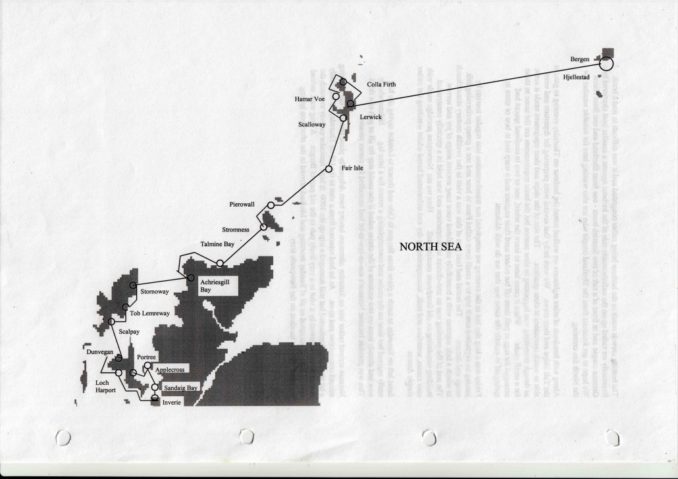
FAIR ISLE
We didn’t leave Scalloway until one-thirty in the afternoon thinking we’d need to find anchorage near Sumburgh Head but once under way whizzed along at 6 knots under full sail in a 12-15 knot easterly breeze.
In later years when mostly single-handing I rarely put out full sail and found that with winds anywhere between 15 and 30 knots Alchemi was just as fast with less heeling and more stable directionally with a single reef in the main and the Yankee and Staysail furled by the right amount for the windspeed. I hadn’t discovered that in 1997 though and wasn’t concerned about raising full sail with a strong crew on board.
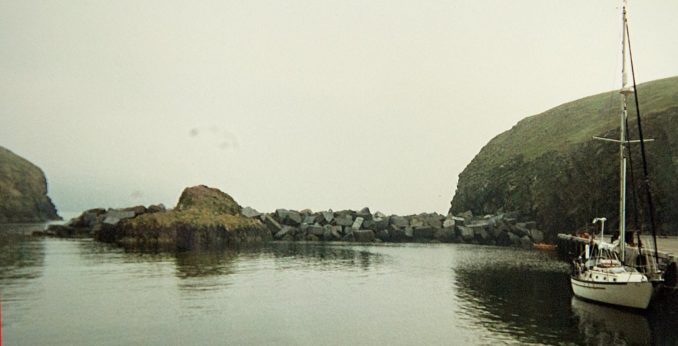
We continued at a steady 6 knots for as many hours which was all we needed to arrive off the entrance to North Haven harbour on Fair Isle. At this latitude there is still a good light until late evening and I was glad of that as we avoided rocks awash to starboard and others to port soon after and kept a steady course through waves reflected from the steep cliff that tried to turn the bow this way and that. We were soon moored against the new quay in the well-protected harbour chatting with the light-house keeper who had seen our approach and come down to greet us.
We learned the island is now owned by the National Trust and is divided into a crofting southern half and an uncultivated northern half. The entire island is famous amongst bird watchers throughout the world and a large chalet provides accommodation for up to thirty people who visit to undertake research, watch the birds or just for the peace and quiet. We were lucky to have this meeting because the light was automated one year later and has not been manned ever since. Other conditions have changed too and the photograph of the same place on the Fair Isle Organisation website shows 12 yachts moored where we were alone in 1997.
The NT (Scotland) still owns the island and I sincerely hope it hasn’t been subject to the Wokery that has infected so many other properties. After many years of neglect by earlier landlords the NT in 1997 had succeeded in stemming depopulation and there were 60-70 permanent residents including six school-age children.
We decided to explore for ourselves next day and made an 8 mile walking tour of both halves. That seems a long way as I write this now, 24 years later, especially as the island is only about half a mile wide and just over two miles long. Here are three pics taken on our tour.
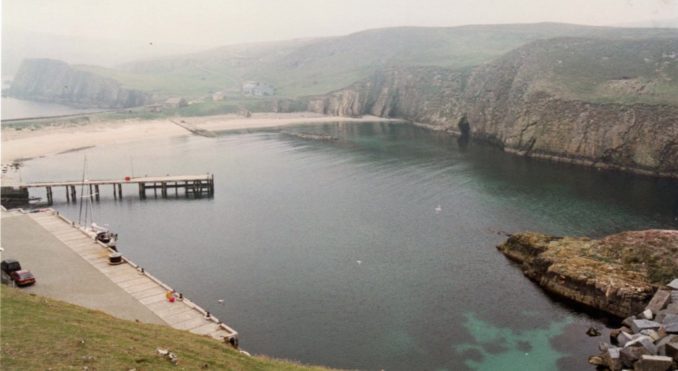

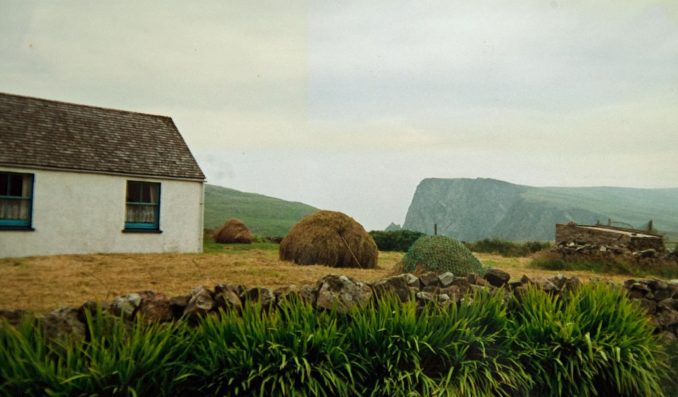
One morning we noticed a rope tied to the quayside ladder with a creel containing live lobsters hanging from it in the perfectly clear water. I forget how we made contact with the fishermen, perhaps they just came to inspect their catch, but we learned it is normally sent to Lerwick for sale in the market there. They were quite happy to sell a couple to us, hauled up the pot and took out two that Michael promptly put in the ship’s bucket in order to estimate their weight. I suspect the fishermen obtained a better price than they would have done from the market but the lobsters seemed good value to us.
Here’s a pic in which I have obscured the faces to protect privacy (a pity because they are a joy to behold but a precaution I thought necessary after reading the other day of a woman who had major complications in her life when she saw her own photograph in an announcement of her unexpected death. It turned out some social media user who didn’t know either woman by sight had searched on the internet for a photo of another woman with the same name to attach to a message to their own friends. News of the death and the photo linked to it had spread far and wide including the victim’s family, friends, and businesses she dealt with).
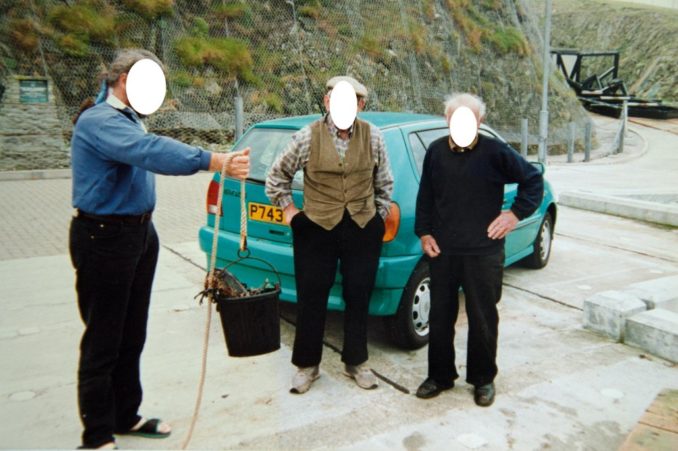

In 1997 there was a weekly ferry service from Lerwick using the Good Shepherd IV built 11 years earlier. Her arrival was the social event of the week and I think most of the island’s population must have come to the quay for one reason or another whilst she was in port.
The Good Shepherd IV still makes the same journey but with additional sailings in the summer. How long she’ll continue to provide the service is a matter of considerable concern according to this report from a year ago. I noticed in the same article the bird observatory was destroyed or badly damaged in a fire so things aren’t looking too bright for inhabitants of Fair Isle right now.
Transport has been improved since 1997 by construction of an airstrip that I don’t think was available then. There are a few scheduled services now and private ‘planes are also allowed if they’re properly licensed. Facilities are a bit limited though – no terminal or hangars but you can tie your ‘plane to the ground if wanting to leave it there overnight. You can also ring up and get the island’s fire engine to stand-by the runway as you arrive if you give them 30 minutes notice.
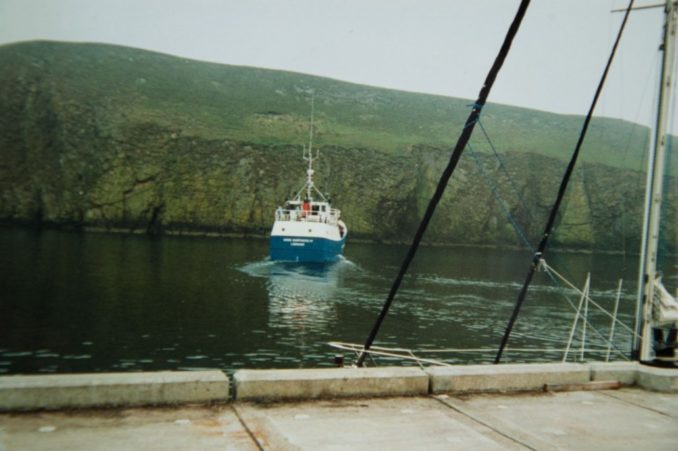
We needed to move on too but couldn’t for a day or two because the harbour became enveloped in a fog so thick we couldn’t even see the cliffs on the far side.
Mist and fog is notoriously common in waters around the Orkneys and Shetlands due to the air being cooler than the warm water brought north by the Gulf Stream. After a couple of days like that I decided we couldn’t delay any longer and used the radar seriously for the first time to achieve and maintain a position mid-way between the cliffs and the end of the breakwater as we left and past the rocks awash just outside the harbour entrance – no worries about chart datum when you can see an image of the boundaries on either side of the yacht’s position in the centre of the radar display.
ORKNEY
We successfully rounded Fair Isle in that way and set course for the Orkney island of Westray. From time-to-time the fog lifted briefly and we could see for a quarter mile or so until it came in again and we had to rely on the radar once more (and remember the fixed GPS wasn’t working and though the hand held one was we couldn’t project its position onto the radar screen so were dependent on visual sighting of the images upon it. That’s more reliable anyway provided the yacht isn’t rocking about too much as the centre of the image is always current position whatever the chart datum. But if the return signal isn’t properly received because of scanner movement up there near the top of the mast a reflected electronic wave might not be stable enough to indicate an object that’s really there).
Strangely, a decent breeze sprang up as well and we were able to sail most of the passage in dense fog at a speed through the water of 4-5 knots. We felt particularly pleased with ourselves when another vessel’s image on the screen proceeding slightly more slowly than we were and on a parallel course turned out to be a fishing boat when the fog finally lifted as we approached Pierowall Roads.
We were greeted warmly by the harbourmaster who showed us where to find the fish processing company’s water hose to fill our nearly depleted tanks. The Scottish couple we had met in Bergen had spoken of the beauty of Pierowall but we didn’t find the place particularly attractive though it is positioned very conveniently for a west-about passage of Orkney.
There was fog again in the morning so we found our way out of the local Sound of Papa by radar but it thinned as the day went on. Then we could see the cliffs but found them less impressive than those of Shetland until the island of Hoy came into view.
As a climber in my youth I was particularly pleased to see the stack known as “The Old Man of Hoy” made nationally famous in the 1960’s by Joe Brown’s televised ascent – superb balance and elegance of movement with nerves of steel – or a poorly developed imagination. I couldn’t find a video of that ascent but here’s one of Joe and his protege Don Whillans re-visiting Dinas Cromlech in the Llanberis Pass in 1985 to repeat one of their most famous climbs together. This was especially nostalgic for me because I and other members of my Climbing Club used to camp in the field at the foot of the cliff at the same time as Brown and Whillans in 1955/6. I hasten to add we didn’t attempt climbs of the same exposure and difficulty as Joe and Don did. I went up and down the pass myself a couple of years ago on one of my caravan expeditions. As in sailing, “The Rocks are Still the Same” but activities are much more regulated and restrictive now and you’re not allowed to camp by the Cromlech boulders any longer.
Soon after passing the “Old Man” one enters Hoy Sound leading into Scapa Flow and Stromness harbour.
Stromness has been Orkney’s major port for centuries for both local boats and ships of exploration, commerce and warfare. The Hudson’s Bay company, formed in 1670 used it as a supply base for 200 years or more. HMS Discovery and HMS Resolution stopped here for water and provisions in 1780 on the way home after Cook’s death in Hawaii the previous year, John Franklin’s ill-fated expedition to discover a north-west passage from the Atlantic to the Pacific started from here in 1845.
Perhaps most well-known of all the German High Seas Fleet was scuttled in Scapa Flow in 1919 to prevent the ships falling into British hands. I don’t suppose Rear Admiral Ludwig von Reuter anticipated he was laying the foundation for a new leisure industry when he gave the order. Nevertheless that’s what he achieved and the Flow now has many dive-sites renowned amongst wreck-diving enthusiasts.
Alchemi too re-provisioned here though that is unlikely to be remembered as long as the visits by her more renowned forebears.
Here’s a photo of the town and one of Alchemi rafted up against a fishing vessel at the Western Pier.
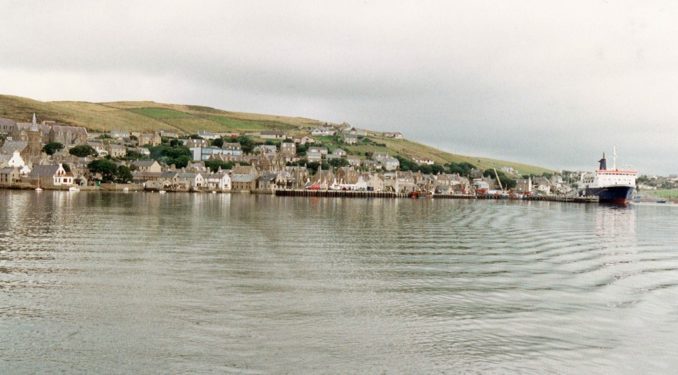

To be continued …………….
© Ancient Mariner 2021


